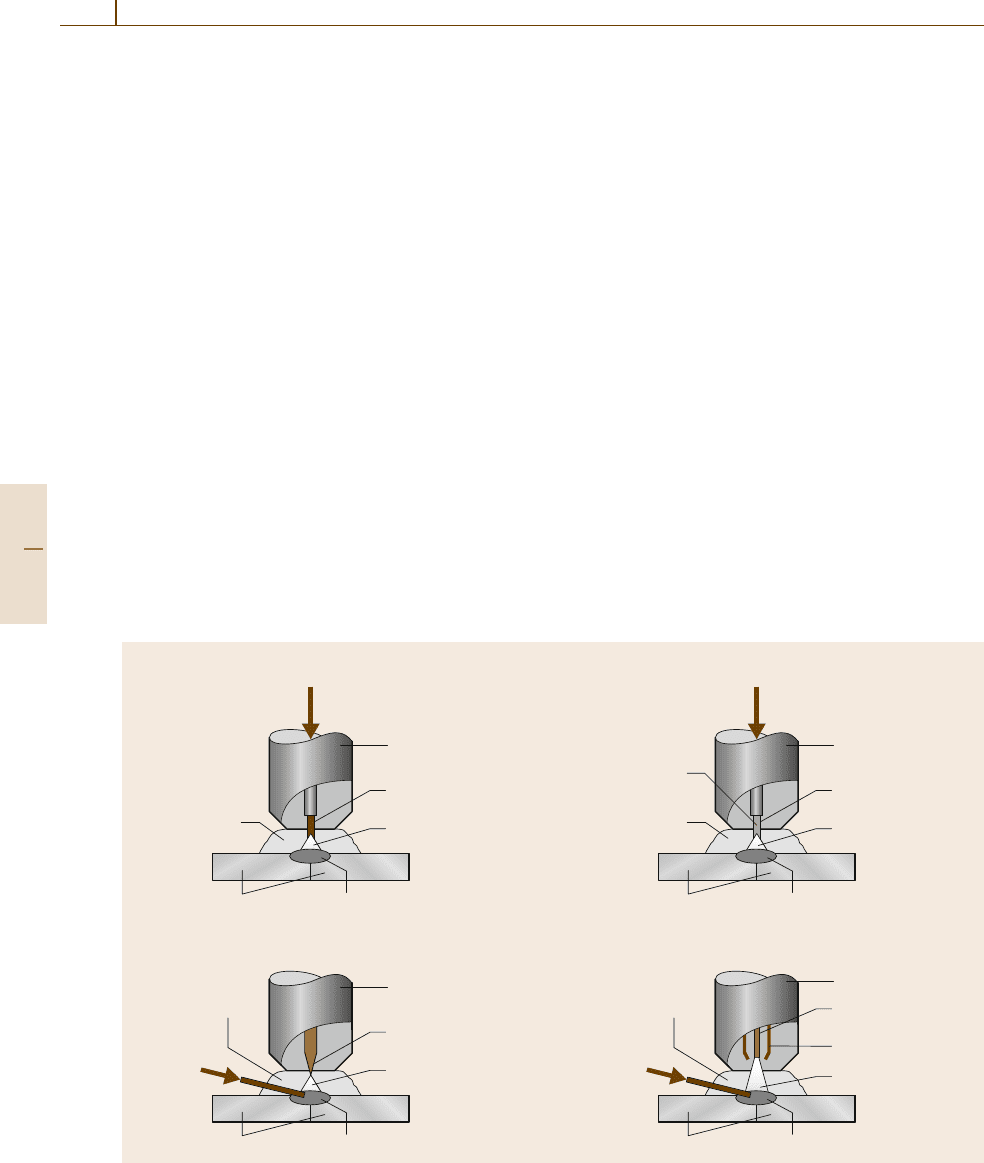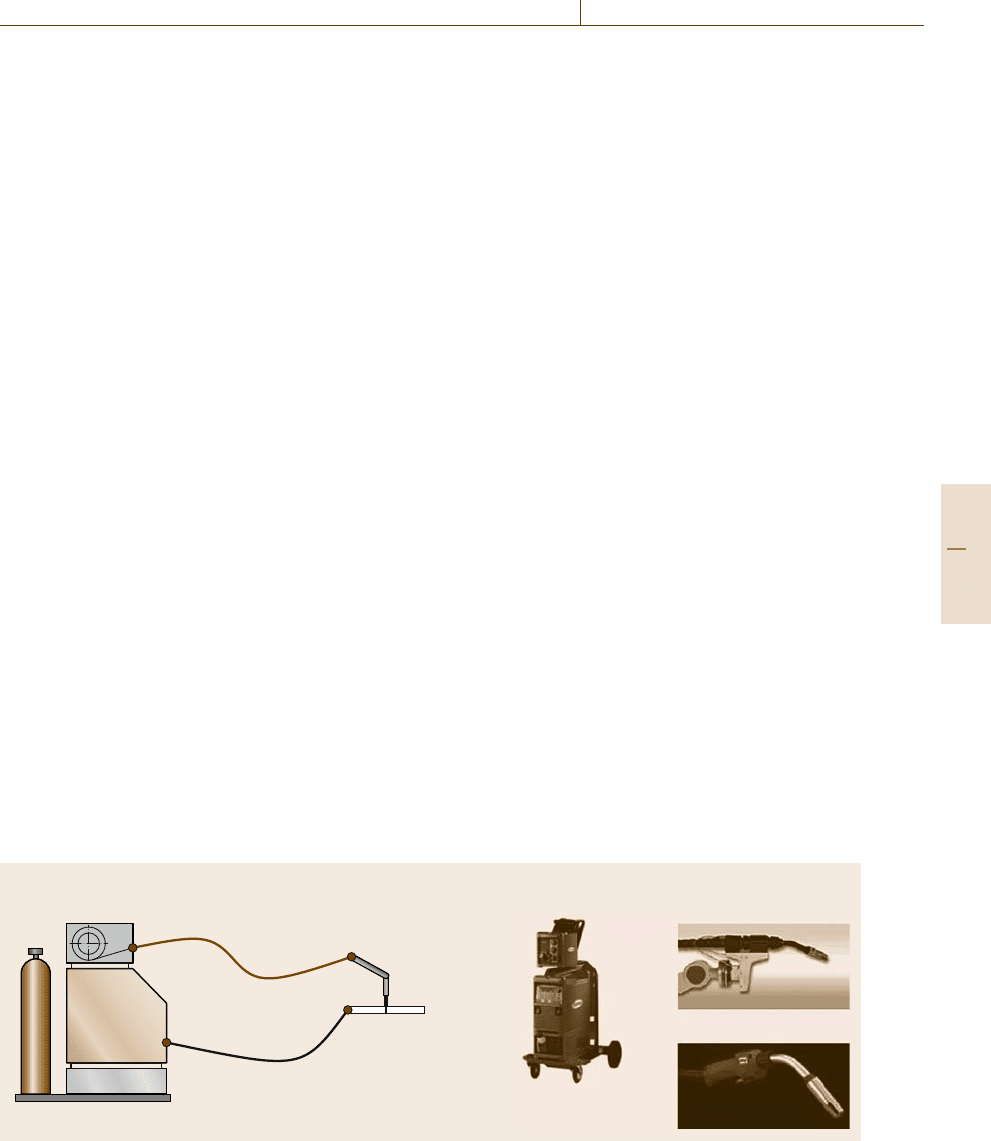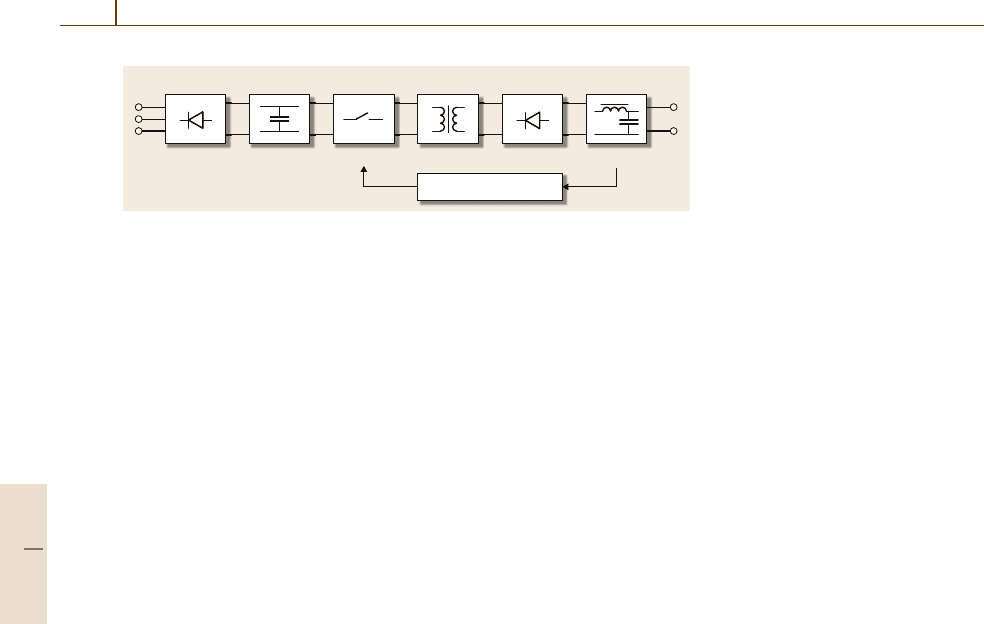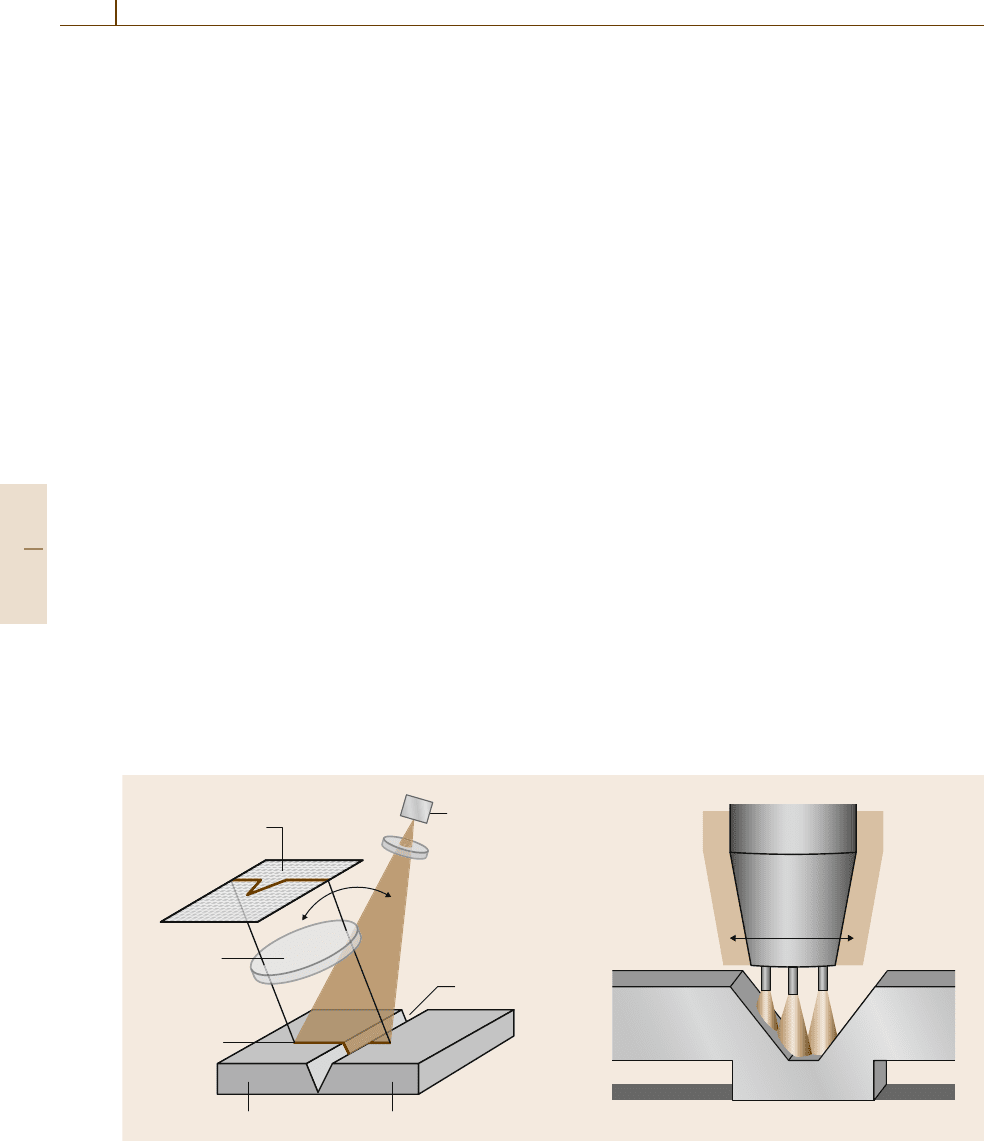Nof S.Y. Springer Handbook of Automation
Подождите немного. Документ загружается.


Automation in the Wood and Paper Industry References 1025
for operators and at the same time enhance their mental
model of the process [58.9, 21]. An expert evaluation
has proved the benefit of 3-D visualization. It would
also be beneficial to implement a sliding mechanism
to analyze data offline. Real process data presented in
3-D, e.g., a surface plot (Fig.58.1b), may be analyzed
in slow or fast motion. By selecting the time frame
to be analyzed the technologist can view the data like
a data player. This is integrated into standard HMI sys-
tems and allows analysis of critical situations as well as
faulty situations in order to increase understanding of
the process. Recent work focuses on application of this
approach for operator training.
Regardingnewtechnological trends,Ethernet-based
fieldbus systems as well as identification technologies
(RFID) need to be evaluated. A first implementation of
Profinet in the cooling and stacking line has been re-
alized. The upcoming question and design decision is
whether Profinet shouldalso be usedfor communication
between PLC, sensors, and actuators, also in hazardous
areas. Market shares outside Europe are hard to pre-
dict but this is a prerequisite before coming to a general
decision for one bus system based on Ethernet standard.
The use of RFID to optimizematerial handling from
the press outlet to customers is being discussed. There
are some constraints that need to be evaluated before
a test, e.g., placement of the RFID (how it can be fixed
to the board before the press or after the cut-to-size
saw); temperature resistance, as the boards are still at
about 100
◦
C at the press outlet; and costs. The idea is
to store all relevant data relating to the board during its
production process on the RFID tag so that customers
have access to the production data on request.
Board-handling satellite data to define the position
of a panel stack in a chaotic storage system may also be
helpful.
References
58.1 US Census Bureau: http://factfinder.census.gov
58.2 D. He, C. Barr: China’s pulp and paper sector: an
analysis of supply-demand and medium term pro-
jections, Int. For. Rev. 6(3–4), 254–266 (2004)
58.3 I. Laukkanen: Visions and requirements of au-
tomation engineering, interview not published
58.4 http://www.VDMA.org
58.5 VDMA: Volkswirtschaft und Statistik. Statistisches
Handbuch für den Maschinenbau (Eigenverlag,
Frankfurt 2007), in German, Transl.: National eco-
nomics and statistics: statistical handbook for
mechanical engineering
58.6 H. Thoemen, P.E. Humphrey: Modeling the physical
processes relevant during hot pressing of wood-
based composites – Part I. Heat and mass transfer,
Holz Roh- Werkst. 64(1), 1–10 (2005)
58.7 B. Scherff, G. Bernardy: Prozessmodellierung führt
zu Online-Qualitätskontrolle und Prozessopti-
mierung bei der Span- und Faserplattenproduk-
tion, Holz Roh- Werkst. 55(3), 133–140 (1997), in
German, Transl.: Process optimization leads to on-
line process control and process optimization in
particle and fiber board production
58.8 H. Thoemen, C.R. Haselein: Modeling the physical
processes relevant during hot pressing of wood-
based composites – Part II. Rheology, Holz Roh-
Werkst. 64(2), 125–133 (2005)
58.9 D. Pantförder, B. Vogel-Heuser: Nutzen von
3-D-Pattern in der Prozessführung am Beispiel
geeigneter Anwendungsfälle, Autom.-Tech. Praxis
11, 62–70 (2006), in German, Transl.: Development
and application of 3-D pattern in process plant
operation – benefit and state of the art
58.10 http://www.siempelkamp.com
58.11 IEEE: Proceedings of the 24th Annual Confer-
ence of IEEE (Industrial Electronics Society, Aachen
1998)
58.12 G. Bernardy, B. Scherff: SPOC – process modeling
provides online quality control and predictive pro-
cess control in particle and fibreboard production,
Proc. 24th Ann. Conf. IEEE (Industrial Electronics
Society, Aachen 1998) pp. 1703–1707
58.13 http://www.metsopanelboard.com/panelboard
58.14 H.-J. Deppe, K. Ernst: Taschenbuch der Span-
plattentechnik, 4th edn. (DRW, Leinfelden-
Echterdingen 2000), in German, Transl.: Paperback
of Particle Board Technique
58.15 G. Bernardy, B. Scherff: Savings potential in chip-
board and fibreboard, cost reduction by the
integration of process control technology and sta-
tistical process optimisation, Asian Timber 1,37–40
(1996)
58.16 G. Bernardy, A. Lingen: Prozessdatenbasierte
Online-Qualitätskontrolle für die kontinuierliche
Überwachung von Prozessen mit zerstörender
Stichprobenprüfung, Autom.-Tech. Praxis 9, 44–51
(2002), in German, Transl.: Process data based on-
line quality control for processes with destructive
test of samples
58.17 M. Blatzheim: Automatisierungstechnik in der
Papierindustrie, Stand der Technik und beson-
dere Anforderungen, Autom.-Tech. Praxis 2,61–63
(2007), in German, Transl.: Automation in the pa-
per industry, State of the Art and other special
requirements
58.18 C.J. Biermann: Handbook of Pulping and Paper-
making, 2nd edn. (Academic, San Diego 1996)
58.19 http://www.sysml.org
Part F 58

1026 Part F Industrial Automation
58.20 http://www.es.eecs.uni-kassel.de/forschung/
projekte/uml2iec61131/e_index.html
58.21 B. Vogel-Heuser, K. Schweizer, A. van Burgeler,
Y. Fuchs, D. Pantförder: Auswirkungen einer drei-
dimensionalen Prozessdatenvisualisierung auf die
Fehlererkennung, Z. Arbeitwiss. 1, 23–34 (2007), in
German, Transl.: Benefits of 3-D process visualiza-
tion on fault detection in process plant operation
Part F 58

1027
Welding Auto
59. Welding Automation
Anatol Pashkevich
This Chapter focuses on automation of welding
processes that are commonly used in industry
for joining metals, thermoplastics, and composite
materials. It includes a brief review of the most im-
portant welding techniques, welding equipment
and power sources, sensors, manipulating devices,
and controllers. Particular emphasis is given to
monitoring and control strategies, seam-tracking
methods, integration of welding equipment with
robotic manipulators, computer-based control ar-
chitectures, and offline programming of robotic
welding systems. Application examples demon-
strating state-of-the-art and recent advances in
robot-based welding are also presented. Conclu-
sions define next challenges and future trends in
enhancing of welding technology and its automa-
tion potential, modeling and control of welding
processes, development of welding equipment
and dedicated robotic manipulators, automa-
tion of robot programming and process planning,
human–machine interfaces, and integration of
the automated robotic stations within the global
production system.
59.1 Principal Definitions .............................1027
59.2 Welding Processes ................................1028
59.2.1 Arc Welding .................................1028
59.2.2 Resistance Welding ......................1029
59.2.3 High-Energy Beam Welding...........1030
59.3 Basic Equipment and Control Parameters1031
59.3.1 Arc Welding Equipment.................1031
59.3.2 Resistance Welding Equipment ......1032
59.4 Welding Process Sensing, Monitoring,
and Control..........................................1033
59.4.1 Sensors for Welding Systems ..........1033
59.4.2Monitoring and Control of Welding.1035
59.5 Robotic Welding ...................................1035
59.5.1 Composition
of Welding Robotic System ............1035
59.5.2Programming of Welding Robots ....1037
59.6 Future Trends in Automated Welding .....1038
59.7 Further Reading ...................................1039
References ..................................................1039
59.1 Principal Definitions
Welding is a manufacturing process by which two
pieces of materials (metals or thermoplastics) are joined
together through coalescence. This is usually achieved
by melting the workpieces and adding a filler ma-
terial that causes the coalescence and, after cooling,
forms a strong joint. Sometimes, pressure is applied
in combination with heat, or alone. At present, heat
welding is the most common welding process, which
is widely used in automotive, airspace, shipbuilding,
chemical and petroleum industries, power generat-
ing, manufacturing of machinery, and other areas
[59.1–3].
For heat welding,many different energy sources can
be used, including a gas flame, an electric arc, a laser
or an electron beam, friction, etc. Depending on the
mode of energy transfer, the American Welding Soci-
ety (ASW) has grouped welding/joining processes and
assigned them official letter designations, which are
used for identification on drawings and in technologi-
cal documentation. In particular, the ASW distinguishes
arc welding, gas welding, resistance welding, solid-
state welding,andother welding processes.Within each
group, processes are distinguished depending on the in-
fluence of capillary attraction (which is the ability of
Part F 59

1028 Part F Industrial Automation
a substance to draw another substance into it). For in-
stance, the arc welding group includes gas metal arc
(GMAW), gas tungsten arc (GTAW), flux cored arc
welding (FCAW), and other types of welding. Detailed
and complete classification of the welding processes is
given in [59.4].
59.2 Welding Processes
59.2.1 Arc Welding
This groupuses an electric arcbetween an electrode and
the base material in order to melt metals at the welding
point. The arc is created by direct or alternating cur-
rent using consumable or nonconsumable electrodes.
The welding region may also be protected from at-
mospheric oxidation and contamination by an inert or
semi-inert gas (shielding gas). Theoldest process of this
type, carbon arc welding (CAW), uses a carbon elec-
trode and has limited applications today. It has been
replaced by metal arc welding. A typical example is
shielded metal arc welding (SMAW), in which a flux-
covered metal electrode produces both shielding (CO
2
from decomposition of the covering) and filler metal
(from melting of the electrode core). This process is
widely used in manual welding and is rather slow, since
Electrode
wire feed
a) Gas metal arc welding (GMAW)
Nozzle
Consumable electrode
Electric arc
Weld metalWorkpieces
Shielding gas
Electrode
wire feed
b) Flux-cored arc welding (FCAW)
Nozzle
Consumable tubular
electrode
Electric arc
Weld metalWorkpieces
Shielding gas
(optional)
Flux core
c) Gas tungsten arc welding (GTAW)
Nozzle
Tungsten electrode
(nonconsumable)
Consumable
electrode
Electric arc
Weld metalWorkpieces
Shielding gas
Tungsten electrode
(nonconsumable)
Consumable
electrode
Shielding gas
d) Plasma arc welding process (PAW)
Nozzle
Plasma stream
Arc constricting
orifice
Weld metalWorkpieces
Fig. 59.1a–d Schematics of typical arc welding processes: (after [59.4])
the consumable electrode rods (or sticks) must be fre-
quently replaced.
Automatic arc welding is mainly based on the gas
metal arc welding (GMAW) process, also known as
metalinertgas(MIG) or metal active gas (MAG)weld-
ing [59.5]. The process uses a continuous wire feed
as a consumable electrode and an inert or semi-inert
gas mixture as shielding (Fig.59.1a). The wire elec-
trode is fed from a spool, through a welding torch.
Since the electrode is continuous, this process is faster
compared than SMAW. Besides, the smaller arc size
allows making overhead joints. However, the GMAW
equipment is more complex and expensive, and requires
more complex setup. During operation, the process is
controlled with respect to arc length and wire feeding
speed. GMAW is the most common welding process in
industry today; it is suitable for all thicknesses of steels,
Part F 59.2

Welding Automation 59.2 Welding Processes 1029
aluminum, nickel, stainless steels, etc. This process
has many variations depending on the type of welded
metal and shielding gas, and also the metal transfer
mode.
A related process, flux-cored arc welding (FCAW),
uses similar equipment but is based on a continuously
fed flux-filled electrode, which consists of a tubular
steel wire containing flux (a substance which facili-
tates welding by chemically cleaning the metals to be
joined [59.1]) at its core (Fig.59.1b). The heat of the arc
decomposes theelectrode coreproducing gas for shield-
ing and also deoxidizers, ionizers, and purifying agents.
Additional shielding may be obtained from externally
supplied gas. Obviously, this cored wire is more expen-
sive than the standard solid one, but it enables higher
welding speed and greater metal penetration.
Another variation is submerged arc welding (SAW)
that is also based on the consumable continuously fed
electrode (solid or flux cored), but the arc zone is pro-
tected by being submerged under a covering layer of
granular fusible flux. When molten, the flux generates
protective gases and provides a current path between
the electrode and the base metal. Besides, the flux cre-
ates a glass-like slag, which is lighter than the deposited
metal from the electrode, so the flax floats on the sur-
face as a protective cover. This increases arc quality,
since atmospheric contaminants are blocked by the flux.
Also, working conditions are much better because the
flux hides the arc, eliminating visible arc light, sparks,
smoke, and spatters. However, prior to welding, a thin
layer of flux powder must be placed on the welding
surfaces.
For nonferrous materials (such as aluminum, mag-
nesium, and copper alloys) and thin sections of stainless
steel, welding is performed by the gas tungsten arc
welding (GTAW) process, also referred to as tungsten
inert gas (TIG) welding. The process uses a noncon-
sumable tungsten electrode with high melting tempera-
ture, so the arc heat causesmelting of the workpiece and
additional filling wire only (Fig.59.1c). As an option,
the filling metal may not be used (autogenous welding).
The weld area is protected from air contamination by
a stream of inert gas, usually helium or argon, which is
fed through the torch. Because of the smaller heat zone
and weld puddle, GTAW yields better quality compared
with other arc welding techniques, but is usually slower.
The process also allows a precise control, since heat in-
put does not depend on the filler material rate. Another
advantage is the wide range of materials that can be
welded, so this process is widely used in the airspace,
chemical, and nuclear power industries.
A related process, plasma arc welding (PAW), uses
a slightly different welding torch to produce a more
focused welding arc. In this technique, which is also
based on a nonconsumable electrode, an electric arc
transforms an inert gas into plasma (i.e., an electrically
conductive ionized gas of extremely high temperature)
that provides a current path between the electrode and
the workpiece (Fig.59.1d). Similar to the GTAW pro-
cess, the workpiece is melted by the intense heat of the
arc, but very high power concentration is achieved. To
initiate the plasma arc, a tungsten electrode is located
within a copper nozzle. First, a pilot arc is initiated
between the electrode and nozzle tip, then it is trans-
ferred to the workpiece. Shielding is obtained from
the hot ionized gas (normally argon) issuing from the
orifice. In addition, a secondary gas is used (argon, ar-
gon/hydrogen or helium), which assists in shielding.
PAW is characterized by extremely high temperatures
(30000
◦
F), which enables very high welding speeds
and exceptionally high-quality welds; it can be used
for welding of most commercial metals of various
thicknesses. A variation of PAW is plasma cutting, an
efficient steel cutting process.
59.2.2 Resistance Welding
Resistance welding is a group of welding processes in
which the heat is generated by high electrical current
passing through the contact between two or more metal
surfaces under the pressure of copper electrodes. Small
pools of molten metal are formed at the contact area,
which possess the highest electrical resistance in this
circuit. In general, these methods are efficient and pro-
duce little pollution, but their applications are limited to
relatively thin materials. There are several processes of
this type; two of them are briefly described below.
Resistance spot welding (RSW)isusedtojoinover-
lapping thin metal sheets, typically, of 0.5–3.0mm
thickness. It employs two nonconsumable copper al-
loy electrodes to apply pressure and deliver current to
the welding area (Fig. 59.2a). The electrodes clamp the
metal sheets together, creating a temporary electrical
circuit through them. This results in rapid heating of
the contact area to the melting point, which is trans-
formed into a nugget of welded metal after the current
is removed. The amount of heat released in the spot is
determined by the amplitude and duration of the cur-
rent, which are adjusted to match the material and the
sheet thickness. The size and shape of the spots also
depend on the size and contour of the electrodes. The
main advantages of this method are efficient energy use,
Part F 59.2

1030 Part F Industrial Automation
F
F
a) Resistance spot welding (RSW)
Weld metal
Workpieces
Electrode
Electrode
Current
supply
F
F
b) Resistance seam welding (RSEW)
Weld metal
Workpieces
Electrode roller
Electrode roller
Current
supply
Fig. 59.2a,b Schematics of typicalresistance weldingpro-
cesses (after [59.4])
low workpiece deformation, no filler materials, and no
requirements forthe welding position. Besides, this pro-
cess allows high production rates and easy automation.
However, the weld strength is significantly lower than
for other methods, making RSW suitable for certain
applications only (it is widely used in the automotive in-
dustry where cars can have up to several thousand spot
welds).
Resistance seam welding (RSEW) is a modification
of spot welding where the bar-shaped electrodes are
replaced by rotating copper wheels. The rotating elec-
trodes are moved along the weld line (or vice versa,
the workpiece is moved between the electrodes), pro-
gressively applying pressure and creating an electrical
circuit (Fig.59.2b). This allows obtaining long contin-
uous welds (for direct current) or series of overlapping
spot welds (for alternative or pulsed current). In seam
welding, more complicated control is required, involv-
ing coordination of the travel speed, applied pressure,
and electrical current to provide the overlapping welds.
This process may be automated and is quite common
for making flange welds, watertight joints for tanks,
and metal containers such as beverage cans. There are
a number of process variants for specific applications,
which include wide wheel seam, narrow wheel seam,
consumable wire seam welding, and others.
59.2.3 High-Energy Beam Welding
Energy beam welding is a relatively new technology
that has become popular in industry due to its high
precision and quality [59.6]. It includes two main pro-
cesses, laser beam welding and electron beam welding,
differing mainly in the source of energy delivered to the
welding area. Both processes are very fast, allow for au-
tomation, and are attractivefor high-volume production.
Laser beam welding (LBW) uses a concentrated
coherent light as the heat source to melt metals to
be welded. Due to the extremely high energy concen-
tration, it produces very narrow and deep-penetration
welds with minimum heat-effective zones. Welds may
be fabricated with or without filler metal; the molten
pool is protected by an externally supplied shield-
ing gas. It is a versatile process, capable of welding
most commercially important metals, including steel,
stainless steel, titanium, nickel, copper, and certain
dissimilar metal combinations with a wide range of
thickness. By using special optical lenses and mirrors,
the laser beam can be directed, shaped, and focused
on the workpiece surface with great accuracy. Since
the light can be transmitted through the air, there is no
need for vacuum, which simplifies equipment and low-
ers operating cost. The beam is usually generated using
a gas-based CO
2
solid-state Nd:yttrium–aluminum–
garnet (YAG ) or semiconductor-based diode lasers,
which can operate in pulsed or continuous mode. Fur-
thermore, the beam is deliveredto the weld area through
fiber optics. For welding,the beam energy is maintained
below the vaporization temperature of the workpiece
material (higher energy is used for hole drilling or cut-
ting where vaporization is required). Advantages of
LBW include high welding speed, high mechanical
properties, low distortion, and no slag or spatter. The
process is commonly used in the automotive industry.
A derivative of LBW, dual laser beam welding,uses
two equal power beams obtained by splitting the orig-
inal one. This leads to a further increase in welding
speed and improvement of cooling conditions. Another
variation, laser hybrid welding, combines the laser with
metal arc welding. This combination also offers advan-
tages, since GMAW supplies molten metal to fill the
joint, and a laser increases the welding speed. Weld
quality is higher as well, as the potential for undercut-
ting is reduced.
Electron beam welding (EBW) is a welding pro-
cess in which the heat is obtained from high-velocity
electrons bombarding the surfaces to be joined. The
electrons are accelerated to a very high velocity (about
Part F 59.2

Welding Automation 59.3 Basic Equipment and Control Parameters 1031
50% of the speed of light), so beam penetration is
extremely high and the heat-affected zone is small,
allowing joining of almost all metals and their com-
binations. To achieve such a high electron speed and
to prevent dispersion, the beam is always generated in
high vacuum and then delivered to the workpiece lo-
cated in a chamber with medium vacuum or even out
of vacuum. In the last case, specially designed ori-
fices separate a series of chambers at various vacuum
levels. Because of the vacuum, a shielding gas is not
used, while a filler metal may be used for some mater-
ials (for deoxidizing the melted plain carbon steel that
emits gases, to prevent weld porosity). The EBW pro-
cess provides very narrow and high-quality welds; it is
commonly used for joining stainless steels, superalloys,
and reactive and refractory metals. The primary disad-
vantage of the EBW is high equipment cost and high
operation price (due to the need for vacuum). Besides,
location of the parts with respect to the beam must be
very accurate.
59.3 Basic Equipment and Control Parameters
The described welding technologies utilize various
types of equipment and control units. However, since
arc and resistance spot welding are used in manufac-
turing most widely, they are expanded upon in more
detail.
59.3.1 Arc Welding Equipment
Arc-welding processes employ the basic electrical cir-
cuit, where the currents typically vary from 100 to
1000A, and voltage ranges from 10 to 50V. The power
supply can produce either direct current (DC) or alter-
nating current (AC), and usually can maintain either
constant current or constant voltage. Consumable-
electrode processes (such as GMAW) generally use
direct current, while nonconsumable-electrode pro-
cesses (GTAW, etc.) can use either direct current (with
negative electrode polarity) or alternating current (with
square-wave AC pattern) [59.1,3,5].
For arc welding processes, the voltage is directly
related to the arc length, and the current is related
Cathode cable
Water cooling
Wire feed
Gas
Power supply
and control
Welding gun
(+)
Welding guns:
Power supply
for robotic welding
for manual welding
Workpiece
(–)
Anode cable,
gas, water,
electrode wire
Fig. 59.3 Composition of a typical GMAW machine and its components (http://www.robot-welding.com/
welding_torch.htm, http://www.binzel-abicor.com)
to the amount of heat produced. So, constant-current
power supplies are most often used for manual welding,
because they maintain a relatively constant heat out-
put even if the voltage varies due to imperfect control
of electrode position. Constant-voltage power supplies
are usually utilized for automated welding, since the
electrode spatial position (and arc length) is proper con-
trolled and the current sensor can be used for adjusting
the electrode position in the feedback loop.
Typical welding equipment for the GMAW pro-
cessisshowninFig.59.3. It includes a power supply,
welding cables, a welding gun, a water cooling unit,
a shielding gas supplier, wire feed system, and a pro-
cess control unit. Here, the cathode (negative) cable is
connected to the workpiece, and the anode (positive)ca-
ble is connected to the welding gun. The consumable
welding wire is continuously fed through the gun cable
and the contact tube inside the gun, where an electrical
connection is made to the power supply. In addition, the
shielding gas and cooling water are also fed through the
gun cable. The welding gun can be operated either man-
Part F 59.3

1032 Part F Industrial Automation
50 Hz
Rectifier
DC
Filter
50 kHz
Switch
50 kHz
Transformer
Control feedback
50 kHz
Rectifier
DC
Filter
Fig. 59.4 General structure of the
inverter-based welding power supply
ually or automatically, by a welding robot or some other
automated setup. The gun shape is usually a swan-neck
or straight. Guns with low current and light duty cy-
cle are generally gas-cooled whereas those with higher
current are water-cooled.
Formerly, welding machines were based on simple
transformers with the operational frequency of the main
energy source (i.e., 50 or 60Hz). For DC welding, the
transformer was equipped with a rectifier and an addi-
tional low-pass filter tosuppress the ripples and produce
a process-stabilizing effect. In modern inverter-type
equipment (Fig.59.4) the main conversion is performed
at much higher frequency (approximately 20–50kHz)
allowing to decrease transformer weight, size, and mag-
netic losses (by about tenfold).
The output stage of the power supply may also
include a controlled on/off switch circuit. By vary-
ing the on/off period (i.e., the pulse duty factor), the
average voltage may be perfectly adjusted. For AC
welding, the power source implements additional fea-
tures such as pulsing the welding current, variable
frequencies, variable ratio of positive/negative half-
cycles, etc. This allows adjustingthe square-wave shape
to minimize the electrode thermal stress and the clean-
ing effect. In some cases, an AC sine wave is combined
with high-frequency high voltage in the neighborhood
of zero-crossing, to ensure noncontact arc reignition.
Other variants use pulsed DC current of low-frequency
(1–10Hz) to reduce weld distortions and compensate
cast-to-cast variations.
By relevant settings of welding parameters,it is pos-
sible to select three possible modes of operation (short
arc mode, spray mode, and globular mode), which
are distinguished by the way in which metal is trans-
ferred. The weld orientation relative to gravity, torch
travel speed, and electrode orientation relative to the
welding joint also have considerable influence on the
weld formation. For most materials, electrode angles of
60–120
◦
give welds with adequate penetration-depth-
to-width ratio. Insome cases,electrode cross-oscillation
(weaving) is necessary. Other important control param-
eters are electrode feed speed, distance between the
workpiece and contact nozzle, travel motion parameters
(straight or weaving type), composition of shielding
gas, and delivery of cooling gas/water.
59.3.2 Resistance Welding Equipment
The implementation of resistance spot welding involves
coordinated application of force and current of the
proper magnitudeand time profile.Typically the current
is in the range of 1–100kA, and the electrode force is
1–20kN. For the common combination “1.0+1.0mm”
sheet steel, the corresponding voltage between the elec-
trodes is only 1.0–1.5 V, however the voltage from the
power supply is much higher (5–10V) because of the
very large voltage drop in the electrodes [59.2–4].
The spot welding cycle is divided into four time
segments: squeeze, heat (weld), cool (hold), and off,
as shown in Fig.59.5. The squeeze segment provides
time to bring the electrodes into contact with the work-
piece and develop full force. The heat segment is the
interval during which the welding current flows through
the circuit. The cool segment, during which the force
is still held, allows the weld to be solidified, and the
off segment is to retract the electrodes, and remove
or reposition the workpiece. Typical values for the
heat and hold times are 0.1–0.5s and 0.02–0.10s,
respectively. In industry, the segment duration is of-
ten expressed in cycles of the main frequency (50 or
60Hz).
Typical equipment for resistance welding includes
the power supply with secondary lines, the electrode
pressure system, and the control system. This structure
applies to both spot and roller seam welding machines.
Differences are in the type of electrode fittings and in
the electrode shapes. For spot welding, the guns nor-
mally include a pneumatic or hydraulic cylinder and are
designed to fit a particular assembly. The most common
are C-type and X-type guns (Fig.59.6), which differ in
shape and force application mechanisms (in the first
case, the cylinder is connected directly to the mov-
ing electrode; in the second case, it is connected via
the lever arm). However, some new welding guns in-
corporate built-in electromechanical actuators for force
generation.
Part F 59.3

Welding Automation 59.4 Welding Process Sensing, Monitoring, and Control 1033
Resistance welding may employ several power
supply architectures that differ in the type of the cur-
rent (AC/DC) and frequency of voltage conversion:
AC power source based on a low-frequency (50 or
60Hz) step-down transformer; DC power source with
a low-frequency (50 or 60 Hz) transformer and rec-
tifier; impulse capacitive-discharge source, where the
rectified primary current is stored in capacitors and
is transformed into high welding currents; inverter-
based power source, where the primary supply voltage
(50 or 60 Hz) is rectified and is converted to a mid-
frequency (20–50kHz) square wave. Similar to arc
welding, the inverter-based method gives essential
reduction of power supply size and weight. All meth-
ods may be used with single- or three-phase mains
supply.
From a compositional point of view, there are two
main types of resistance welding equipment. In the first
type, an AC power unit with electric transformer is
built directly into a welding gun. The second type uses
a DC power unit with welding cables connected to the
gun.
Modern computer-based control units allow pro-
gramming of all essential process parameters, such as
current magnitude, welding cycle times, and electrode
force. Some sophisticated controllers also allow regula-
tion of current during welding, control of pre/post-heat
operations, or adjustment of the clamping force during
the cycle. Particular values of the welding parameters
depend on the physical properties and thickness of the
Squeeze Heat (weld) Cool (hold) Off
Force
Current
Fig. 59.5 Spot welding cycle
Fig. 59.6 Spot welding guns (X-type and C-type)
(http://www.spotco.com)
joining materials, and also on the type of equipment
used. Weld current shape is usually rectangular, but can
also be trapezoid type with programmed rise/fall times.
For some thick materials, several current pulses may be
applied.
59.4 Welding Process Sensing, Monitoring, and Control
Automated welding requires accomplishing a number
of tasks (such as weld placement, weld joint track-
ing, weld size control, control of the weld pool, etc.)
that are based on real-time monitoring and control of
relevant parameters. These actions must be performed
in the presence of disturbances caused by inaccurate
joint geometry, misalignment of workpiece and weld-
ing tool, variations in material properties, etc. The
main challenge is that the observable data is indi-
rectly related to final weld quality, so sensing and
feedback control relies on a variety of techniques.
Basically, they are divided into groups (technologi-
cal and geometrical), which provide correspondingly
control/monitoring of the welding process and posi-
tioning of the workpiece relative to the energy source
[59.7,8].
59.4.1 Sensors for Welding Systems
For welding, technological parameters typically include
voltage, current, and wire feed speed. The arc voltage
is usually measured at the contact tube within the weld
torch, but the voltage drop betweenthe tubeand the wire
tip (where the arc starts) must be compensated. Another
method is to measure the voltage on the wire inside the
feeding system, which provides a more accurate result.
The welding current can be measured using two
types of sensors, the Hall-effect sensor and current
shunt. The former is a noncontact device that responds
to the magnetic field induced by the current. The second
sensor type employs a contact method where the current
flows through a calibrated resistor (shunt) that converts
the current into a measured voltage.
Part F 59.4

1034 Part F Industrial Automation
The wire feed speed is usually estimated by mea-
suring the speed of the drive wheel of the feeder unit.
However, this must be complemented with special fea-
tures of the feeder mechanics, which ensures robustness
with respect to wire diameter variations and bend-
ing/twisting of the wire conduit.
Sensors for geometrical parameters provide the data
for seamtracking duringwelding and/orseam searching
before welding. These capabilities ensure adaptation to
the actual (i.e., nonnominal) weld joint geometry and
the workpiece position/orientation relative to the torch.
The most common geometrical sensors are based on
tactile, optical or through-arc sensing principles.
Tactile sensors implement purely mechanical prin-
ciples, where a spring-loaded guide wheel maintains
a fixed relationship between the weldtorch and the weld
joint. In more sophisticated sensors the signals from the
mechanical probe are converted into electrical signals to
acquire the geometrical data.
Optical sensors usually use a laser beam, which
scans the seam in linear or circular motions, and
a charge-coupled device (CCD) array that captures
features of the weld joint (Fig. 59.7a). By means of
scanning, the sensor acquires a two-dimensional (2-D)
image of the joint profile. When the welding torch and
sensor are being moved, a full three-dimensional (3-D)
description of the weld joint is created. By applying
appropriate image processing techniques and the tri-
angulation method, it is possible to compute the gap
size and weld location with respect to the welding
torch [59.9]. A laser-based optical sensor is typically
a) b)
Imager
(CCD or
CMOS)
Laser diode
Weave
direction
CLR
Collecting
lens
Laser stripe
Joint
a
Part BPart A
Fig. 59.7a,b Seam tracking using laser scanning (a) and through-arc sensing with weaving (b) (http://www.robot-
icsonline.com, http://www.thefabricator.com)
mounted on the weld torch, ahead of the welding di-
rection, and a one-degree-of-freedom mechanism is
required to maintain this configuration during welding.
A typical laser scanner provides a sweep frequency of
10–50Hz and an accuracy of ±0.1mm, which is suf-
ficient for most of welding processes. However, high
price often motivates the use of alternative sensing
methods.
Through-arc sensing is based on the measurement
of the arc current corresponding to weaving (i.e.,
scanning) torch motions (Fig.59.7b). This is a pop-
ular and cost-effective method for seam tracking in
GMAW and related processes [59.10]. This method
employs the relation between variations of the arc cur-
rent and the electrode/workpiece distance, which is
negative proportional for constant arc voltage. Typi-
cally, triangular-, sinus- or trapezoid-type motions are
used, with a few millimeters of weaving amplitude, to
achieve accuracy of about ±0.25mm. For this method,
geometrical information can be retrieved using con-
tinuous current measurement or its measurements at
the turning and/or center points of the weaving mo-
tion. Correspondingly, different control principles are
applied based on difference computing or template
matching.
In practice, the tracking capability is usually com-
bined with a search function (i.e., preweld sensing of
the joint location), where the torch gradually moves in
a predefined direction until detecting the weld joint.
There are two basic methods for this function, which
differ in terms of sensors and search patterns:
Part F 59.4
